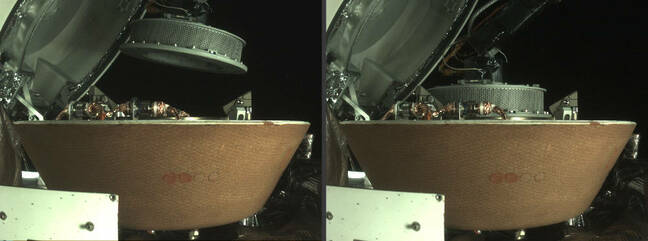This article is more than 1 year old
No need for more asteroid-blasting attempts, NASA's OSIRIS-REx has more than enough space dirt
There may be carbon, water, clay, perhaps even platinum, gold in them hills
NASA has stowed away its first ever sample of asteroid regolith, collected by its OSIRIS-REx spacecraft from space rock Bennu, and is working on bringing the material home for 2023.
“Together a team comprising industry, academia and international partners, and a talented and diverse team of NASA employees with all types of expertise, has put us on course to vastly increase our collection on Earth of samples from space,” said the space agency’s administrator Jim Bridenstine on Friday. “Samples like this are going to transform what we know about our universe and ourselves, which is at the base of all NASA’s endeavors.”

NASA probe stows its asteroid sample ready for return to Earth. Left, the disc containing the material hovers above the collection capsule; right, the disc connected to the capsule, allowing its contents to be safely stored within ... Source: NASA/Goddard/University of Arizona/Lockheed Martin. Click to enlarge
Bennu is 205 million miles (330 million km) away, and scientists believe its surface has been undisturbed since it was formed during the birth of the Solar System 4.5 billion years ago. Boffins hope its soil could reveal the violent past of our planetary system and potentially answer vital questions about how water and other life-supporting compounds ended up on Earth.
NASA hoped to collect at least two ounces (60 grams) of the asteroid’s dirt and soil when earlier this month it carried out a maneuver that involved grazing its surface with a robotic arm known as TAGSAM and shooting gas at the ground to kick up material. It managed to scoop up more than four pounds (2kg) of matter during its first attempt.
The sample collection head placed at the end of the device expelled nitrogen gas to blow away a loose layer of regolith, which was funneled into a metre-wide disc. The probe could attempt the maneuver three times to grab enough soil to take home, though the first time worked a charm and so no further attempts are necessary. Below is a video showing OSIRIS-REx gathering its sample from Bennu using the pressurized gas, as we reported earlier:
Now that the sample is sealed up in the Sample Return Capsule, I can finally share this video from TAG!
— NASA's OSIRIS-REx (@OSIRISREx) October 30, 2020
This is the view from one of my navigation cameras… pretty intense, huh? #ToBennuAndBack
More details: https://t.co/JUSk8YDaow pic.twitter.com/TqPUm9YBvU
Although the sampling process was a success, TAGSAM was so full of dirt, it started leaking. NASA had devised a technique to measure how much extra mass OSIRIS-REx had picked up by getting the spacecraft to spin. That was scrapped due to the leakage; the American agency didn’t want to risk losing more of its precious dirt.
TAGSAM was able to move its regolith haul into the craft's sample return capsule, where the dust and pebbles will remain until OSIRIS-REx gets back to Earth. While scientists aren’t quite sure of the chemical composition of the diamond-shaped asteroid, they reckon the regolith contains a lot of carbon, water, minerals and clay. It might also have traces of platinum and gold, too, present in a higher concentration compared to Earth’s crust.
NASA will hand out a quarter of the sample to various teams of researchers around the world, and keep the rest for itself. Most of it will be preserved for future generations to study.
OSIRIS-REx is expected to continue orbiting Bennu until March 2021 when it will make its way back to Earth and arrives some time in September 2023. ®
